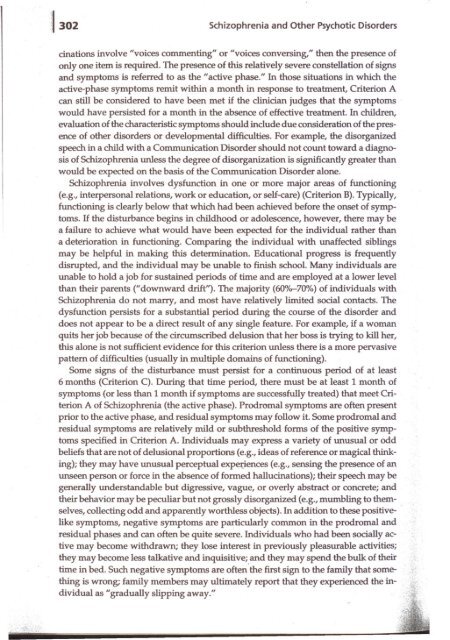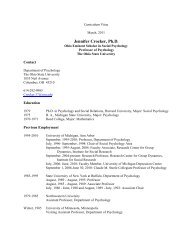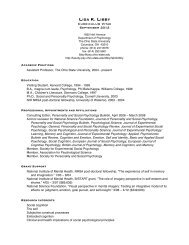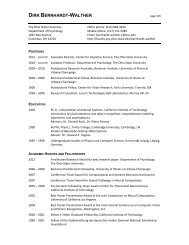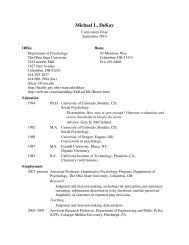Schizophrenia and Other Psychotic Disorders pg297-315.pdf
Schizophrenia and Other Psychotic Disorders pg297-315.pdf
Schizophrenia and Other Psychotic Disorders pg297-315.pdf
Create successful ePaper yourself
Turn your PDF publications into a flip-book with our unique Google optimized e-Paper software.
:1302 <strong>Schizophrenia</strong> <strong>and</strong> <strong>Other</strong> <strong>Psychotic</strong> <strong>Disorders</strong><br />
cinations involve "voices commenting" or "voices conversing," then the presence of<br />
only one item is required. The presence of this relatively severe constellation of signs<br />
<strong>and</strong> symptoms is referred to as the "active phase." In those situations in which the<br />
active-phase symptoms remit within a month in response to treatment, Criterion A<br />
can still be considered to have been met if the clinician judges that the symptoms<br />
would have persisted for a month in the absence of effective treatment. In children,<br />
evaluation of the characteristic symptoms should include due consideration of the presence<br />
of other disorders or developmental difficulties. For example, the disorganized<br />
speech in a child with a Communication Disorder should not count toward a diagnosis<br />
of <strong>Schizophrenia</strong> unless the degree of disorganization is significantly greater than<br />
would be expected on the basis of the Communication Disorder alone.<br />
<strong>Schizophrenia</strong> involves dysfunction in one or more major areas of functioning<br />
(e.g., interpersonal relations, work or education, or self-care) (Criterion B). Typically,<br />
functioning is clearly below that which had been achieved before the onset of symptoms.<br />
If the disturbance begins in childhood or adolescence, however, there may be<br />
a failure to achieve what would have been expected for the individual rather than<br />
a deterioration in functioning. Comparing the individual with unaffected siblings<br />
may be helpful in making this determination. Educational progress is frequently<br />
disrupted, <strong>and</strong> the individual may be unable to finish school. Many individuals are<br />
unable to hold a job for sustained periods of time <strong>and</strong> are employed at a lower level<br />
than their parents ("downward drift"). The majority (60%-70%) of individuals with<br />
<strong>Schizophrenia</strong> do not marry, <strong>and</strong> most have relatively limited social contacts. The<br />
dysfunction persists for a substantial period during the course of the disorder <strong>and</strong><br />
does not appear to be a direct result of any single feature. For example, if a woman<br />
quits her job because of the circumscribed delusion that her boss is trying to kill her,<br />
this alone is not sufficient evidence for this criterion unless there is a more pervasive<br />
pattern of difficulties (usually in multiple domains of functioning).<br />
Some signs of the disturbance must persist for a continuous period of at least<br />
6 months (Criterion C). During that time period, there must be at least 1 month of<br />
symptoms (or less than 1 month if symptoms are successfully treated) that meet Criterion<br />
A of <strong>Schizophrenia</strong> (the active phase). Prodromal symptoms are often present<br />
prior to the active phase, <strong>and</strong> residual symptoms may follow it. Some prodromal <strong>and</strong><br />
residual symptoms are relatively mild or subthreshold forms of the positive symptoms<br />
specified in Criterion A. Individuals may express a variety of unusual or odd<br />
beliefs that are not of delusional proportions (e.g., ideas of reference or magical thinking);<br />
they may have unusual perceptual expe6ences (e.g., sensing the presence of an<br />
unseen person or force in the absence of formed hallucinations); their speech may be<br />
generally underst<strong>and</strong>able but digressive, vague, or overly abstract or concrete; <strong>and</strong><br />
their behavior may be peculiar but not grossly disorganized (e.g., mumbling to them- .<br />
selves, collecting odd <strong>and</strong> apparently worthless objects). In addition to these positivelike<br />
symptoms, negative symptoms are particularly common in the prodromal <strong>and</strong><br />
residual phases <strong>and</strong> can often be quite severe. Individuals who had been socially active<br />
may become withdrawn; they lose interest in previously pleasurable activities;<br />
they may become less talkative <strong>and</strong> inquisitive;.<strong>and</strong> they may spend the bulk of their<br />
time in bed. Such negative symptoms are often the first sign to the family that something<br />
is wrong; family members may ultimately report that they experienced the individual<br />
as "gradually slipping away."


